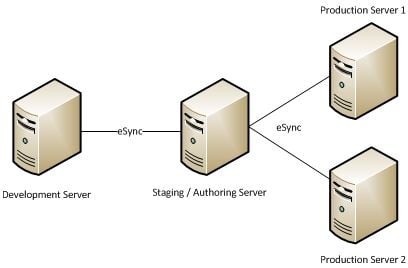How Does eSync Work, and Why Should I Use it?
Chris Osterhout SVP of Strategy#CMS

We take a look at how Ektron eSync is used to manage multi-tier environments at different levels of complexity.
Most enterprise CMS-driven websites need to utilize multiple web and database servers to operate their site, and we’ve previously discussed how Ektron’s eSync product can be used to synchronize content, assets, and templates between different environments. But we wanted to provide a bit more detail about the way eSync is used and the different use cases for multi-tier environments. Let’s take a look at how you can use eSync, from basic configurations to larger, more complex setups.
The Basics: Three-Tier Environments
The most basic use of eSync is for a three-tier environment, consisting of Development, Staging/Authoring, and Production web servers. For this setup, any content changes are made on the Authoring server, allowing them to be reviwed before they are synchronized to the Production server, which contains the live, publically-available version of the site. Any changes to templates or underlying site code are made on the Development server, and then synced to the Authoring server for validation before being moved to the Production server.
This setup allows you to use the Authoring server to make changes and ensure everything looks correct before making it live. Using the Development server for code updates allows you to make changes that will affect the site’s visual structure without altering the environment where content updates are made. The Authoring environment serves as the “master” copy of the site, and changes made there can be moved to Production on either a scheduled basis or on-demand. The Authoring environment’s content will also regularly be synced to the Development environment to ensure that code changes are being tested on the most recent version of the site.

One Step Up: Including a Test Server
For larger sites with a lot of content and many changes being made regularly, it’s best to add a Test server in between the Development and Authoring servers. In this setup, the Authoring environment serves as a “gold master” version of the website, with a schedule set up to sync the Authoring server’s content to Production on a regular (usually hourly) basis. This Authoring server can also serve as a backup to the Production environment, ready to be used as the live version of the site in case the Production server goes down. Large batch content changes will actually be made to the Test server, where content authors/editors can perform User Acceptance Testing (UAT) before syncing their changes to the Authoring server, which serves as a final step in which the changes can be reviewed before being moved live. This configuration streamlines the authoring process, allowing sites with a large amount of content and a large number of content editors to maintain the site (often utilizing an approvals process) without having to micromanage the process of moving each piece of content to Production.

Full Service: Adding Load Balancing and Disaster Recovery
As a website increases in size and traffic, its owners may wish to scale its server environment up even further in order to provide guarantees of uptime and performance. One popular option is Load Balancing, which uses two (or more) Production servers, with traffic being directed to both servers simultaneously in order to ensure the site does not become overloaded. When content is published from the Authoring environment, eSync will push that content to both Production servers, ensuring that all users see the same content. These servers also act as backups to each other in case one of them goes down.

Another popular option is Disaster Recovery, which maintains a copy of the Production environment at a different location than the other servers. If anything causes the main data center to become unavailable, traffic and be routed to this backup server, ensuring that the site always remains up and running. When content is published to the Production environment, eSync will copy it to this Disaster Recovery server as well to ensure that the backup is always ready to go in case it is needed.

A Versatile Solution
eSync is a very powerful tool for enterprise websites, ensuring that the correct content is always live, with editors able to test it and ensure everything is correct before publishing it. By moving content and any associated files or assets at the same time, eSync can maintain perfect synchronization between environments, without the need for any third party solutions. The ability to schedule content syncs or perform them on demand provides a great deal of versatility, and depending on the size of the website and the regularity of changes, the complexity of the environment can be scaled as needed. Diagram are experts in configuring eSync, and we can always answer any questions you might have about your needs. If there’s anything we can help you with, please contact us or let us know in the comments below.
Related Posts
Should You Upgrade Your Website to Umbraco 14?
When deciding whether to upgrade your website to Umbraco 14 there are some important factors to consider - and our post breaks them down for you.

Why Choose a CMS?
We look at the advantages that a Content Management System (CMS) can bring to your digital and content marketing strategy.
Results Matter.
We design creative digital solutions that grow your business, strengthen your brand and engage your audience. Our team blends creativity with insights, analytics and technology to deliver beauty, function, accessibility and most of all, ROI. Do you have a project you want to discuss?
Like what you read?
Subscribe to our blog "Diagram Views" for the latest trends in web design, inbound marketing and mobile strategy.
